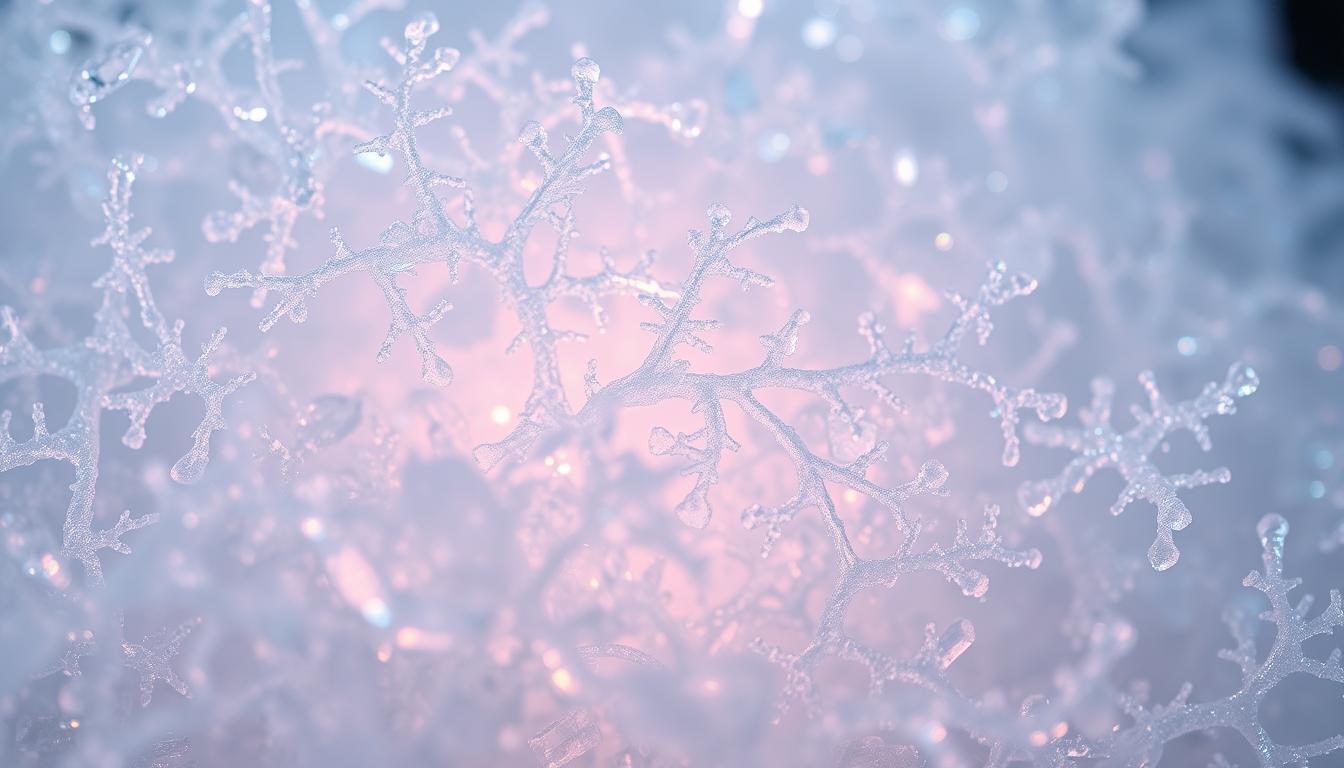Did you know 30% of frozen items in American freezers develop visible texture changes due to moisture loss? This widespread issue stems from a simple scientific process: when stored improperly, your food loses water molecules to the surrounding air. These escaping particles then refreeze into jagged structures on surfaces, altering flavor and quality.
Freezers work by slowing bacterial growth, but their dry environment pulls moisture from unprotected items. Meat, vegetables, and even ice cream can develop frosty patches when exposed to temperature fluctuations or inadequate wrapping. The result? A meal that tastes bland or has an unpleasant rubbery texture.
Proper storage techniques create a barrier against this moisture migration. Airtight containers and specialized wraps help maintain your food’s natural water content. When you minimize air contact, you preserve taste and nutritional value while reducing waste.
Key Takeaways
- Moisture evaporation causes ice buildup on improperly stored items
- Temperature changes accelerate dehydration in frozen products
- Air-tight packaging prevents 80% of freezer-related quality issues
- Surface crystals indicate texture and flavor deterioration
- Consistent freezer temps below 0°F slow crystal formation
Introduction to Frozen Food Challenges
Your freezer holds more than just meals—it preserves safety and convenience when used correctly. Modern freezing methods let you stockpile ingredients for months, but success depends on understanding both science and practical techniques. Not all items survive the deep chill equally, as moisture migration and temperature shifts alter textures dramatically.

An Overview of Freezing and Its Purpose
Freezing acts like a pause button for perishables. By dropping temperatures below 0°F, you slow bacterial growth and enzyme activity that cause spoilage. This process keeps meats safe for up to a year and preserves vegetables’ vitamins better than canning. Yet the USDA notes: “Safety doesn’t guarantee appeal”—improper methods lead to mushy greens or gritty sauces.
Dairy products and prepared meals freeze well when sealed tightly. Soups solidify into compact bricks, while herbs retain flavor if blanched first. But attempt to freeze watery vegetables like celery, and you’ll discover nature’s limits.
Why Maintaining Quality Matters
Texture changes impact your cooking results. Fish that develops ice patches becomes stringy when cooked. Fruits losing cellular structure turn soggy in smoothies. Every quality loss translates to wasted ingredients or compromised dishes.
Smart storage prevents these issues. Vacuum-sealed meats stay juicy for grilling. Glass containers protect casseroles from absorbing odd odors. When you master these methods, your frozen chicken stir-fry tastes nearly fresh-made—saving time and money without sacrificing nutrition.
Understanding Ice Crystals in Frozen Food
That frosty layer on your frozen veggies isn’t just harmless ice—it’s evidence of moisture escaping during storage. These crystalline invaders form when water molecules move from your food’s surface to available air pockets in packaging. The colder your freezer gets, the more pronounced this moisture migration becomes.

What Are Ice Crystals?
Frozen water deposits develop when temperature swings cause repeated thawing and refreezing. You’ll spot them as white speckles on meat surfaces or frosty veils covering leftovers. Their size reveals storage conditions—small, scattered bits suggest brief exposure to warmer air, while dense clusters indicate prolonged temperature instability.
Three factors determine crystal formation speed:
- Packaging material’s vapor resistance
- Consistency of freezer temperatures
- Initial food moisture content
Impact on Food Texture and Flavor
Those sparkly formations steal more than visual appeal. As moisture migrates, proteins in meats tighten into chewy strands. Vegetables lose crispness, becoming limp after cooking. Even ice cream develops an unpleasant grainy mouthfeel when crystals pierce its creamy structure.
Flavor compounds escape with escaping water molecules. Herbs taste muted, while fruits lose their vibrant tang. A USDA study found beef loses 12% of its savory notes after six months of improper freezing. Scrape off light frost immediately before cooking, but discard items resembling snowballs—their quality has irreversibly declined.
What Causes Ice Crystals in Frozen Food?
Three silent saboteurs lurk in every freezer, waiting to dehydrate your meals and create freezer burn. Air exposure, unstable temperatures, and prolonged storage times work together to transform fresh frozen foods into frost-covered disappointments. Recognizing these factors helps you defend against quality loss.

Common Culprits Behind Ice Crystal Formation
Improper packaging causes most freezer burn cases. Gaps in wrapping or loose lids let dry air steal moisture from food surfaces. This dehydration leaves behind the telltale white patches of freezer burn.
Temperature instability accelerates damage. Frequent door openings or faulty seals cause minor thawing cycles. Each warm spell pulls water molecules outward, creating ideal conditions for ice crystal growth.
Extended storage times challenge even the best packaging. Over months, air slowly infiltrates containers, gradually dehydrating frozen foods. That forgotten steak from three months ago? It’s likely developing freezer burn despite initial proper sealing.
These issues often combine forces. Poor packaging magnifies temperature fluctuations, while long storage periods give problems time to develop. The result? Accelerated quality loss that outpaces any single factor’s impact.
The Role of Freezer Burn in Ice Crystal Formation
Freezer burn acts as both a symptom and accelerator of frozen food deterioration. While technically safe to eat, affected items lose their appeal through texture changes and flavor degradation. This condition progresses through distinct stages, with visible signs offering clues to underlying moisture loss.

Identifying Signs of Freezer Burn
Spotting early signs helps prevent irreversible damage. Meats develop gray-brown patches and a leathery surface, while vegetables shrink into wrinkled versions of their former selves. Fruits lose vibrancy, appearing dull or frost-coated.
Three key indicators reveal advancing freezer burn:
- White or translucent ice crystals clinging to surfaces
- Dry, tough textures replacing natural tenderness
- Faded colors signaling oxidation and dehydration
How Freezer Burn Contributes to Ice Crystals
Moisture migration drives this destructive cycle. As water escapes food cells, it freezes into jagged crystals on packaging or exposed areas. These structures grow larger with temperature fluctuations, creating rough textures.
Repeated thaw-refreeze episodes worsen the burn effect. Each cycle pulls more moisture outward, accelerating quality loss. While safe to eat, heavily crystallized foods often develop unpleasant taste profiles resembling cardboard or stale paper.
Packaging and Storage Methods: Key Factors
Your first defense against texture-ruining frost lies in choosing the right armor for your frozen items. Quality materials and smart techniques create an impenetrable shield against dry freezer air.

Using Airtight Containers and Wraps
Not all containers work equally well in subzero conditions. Glass and thick plastic options outperform flimsy packaging by blocking 97% of moisture loss. For irregularly shaped items like roasts, double-wrap with wax paper and heavy-duty foil to eliminate gaps.
| Material | Best For | Durability |
|---|---|---|
| Freezer-grade plastic | Soups, sauces | 6-12 months |
| Tempered glass | Casseroles, leftovers | Indefinite |
| Vacuum-sealed bags | Meats, fish | 2-3 years |
| Aluminum foil | Baked goods | 3-6 months |
Effective Sealing and Minimal Air Exposure
Press out every bubble when using resealable bags—trapped air becomes frost within weeks. For containers, leave ½ inch space for expansion while ensuring lids snap tightly. Label packages with dates using freezer-safe markers to track storage times.
Invest in a vacuum sealer for long-term meat storage. These devices remove 99% of air, extending prime quality by 3x compared to standard wraps. Rotate older items to the front to ensure nothing gets forgotten behind newer additions.
Temperature and Timing Considerations When Freezing
Your freezer’s performance hinges on two critical factors you control daily: climate management and storage duration. Proper settings preserve textures and flavors, while strategic timing prevents gradual quality erosion.
Freezing Temperature Guidelines to Follow
Set your appliance to 0°F (-18°C) or colder—this flash-freezes items before large crystals form. Colder temperatures solidify water molecules faster, creating smaller ice structures that cause less cellular damage.
Keep your freezer at least three-quarters full. A stocked compartment maintains stable conditions better than an empty one. Thermal mass from stored items buffers against temperature swings when you open the door.
- Check settings monthly with an appliance thermometer
- Limit door openings to under 10 seconds
- Organize contents into labeled zones for quick access
Optimal Duration for Storage
Even perfectly sealed foods degrade over time. Follow these maximum timelines for peak quality:
| Food Type | Ideal Duration |
|---|---|
| Raw meats | 6-12 months |
| Vegetables | 8-10 months |
| Prepared meals | 2-3 months |
Label packages with freeze dates using waterproof markers. Rotate older items forward to ensure timely use. Pro tip: Store frequently used foods near the front to reduce rummaging time.
Make sure your appliance maintains consistent cold air circulation. Avoid overpacking shelves—leave space between items for proper airflow. When adding warm leftovers, chill them first to prevent temperature spikes.
Tips for Preventing Ice Crystals and Freezer Burn
Proper preparation before freezing makes all the difference in preserving your food’s quality. Strategic cooling methods and organized storage habits create a strong defense against dehydration and flavor loss. Follow these three essential practices to maintain texture and taste while preventing freezer burn effectively.
Quick Cooling Techniques
Cool cooked foods rapidly to stop bacterial growth. The USDA advises reaching 70°F within two hours using ice baths or refrigerator staging. This method locks in moisture before freezing, reducing crystal formation.
Smart Labeling Systems
Mark every package with the freeze date using waterproof labels. Implement a “first in, first out” rotation to use older items before quality declines. Smaller portions freeze faster and reduce leftovers needing refreezing.
Thawing Discipline
Never refreeze thawed items—plan meal sizes carefully. Partial defrosting pulls water from cells, creating larger ice structures when refrozen. Store foods in single-use quantities to avoid this damaging cycle.
These tips work together to prevent freezer quality issues. Consistent cooling, clear dating, and portion control keep your frozen meals tasting fresh while minimizing waste. Your next defrosted dinner will thank you.



